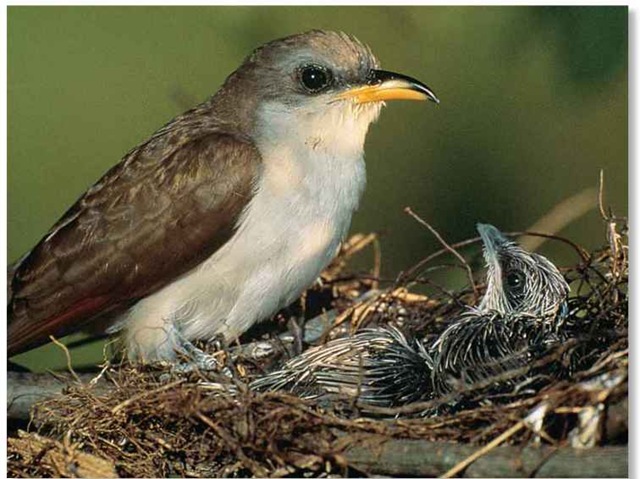ORDER
Cuculiformes
FAMILY
Cuculidae
GENUS & SPECIES
KEY FEATURES
• Wide-set eyes enable it to see to the rear without turning its head
• Able to climb among branches in search of insects when just 9 days old
• Can fly at speeds up to 22 mph
• Rears its own young, unlike the European cuckoo
WHERE IN THE WORLD?
Nests in North America from Canada, throughout most of U.S.; winters in Central and South America; occasionally found in Europe
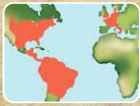
LIFECYCLE
The secretive yellow-billed cuckoo blends well with its surroundings, but its repetitive song reveals its presence throughout the countryside.
HABITAT
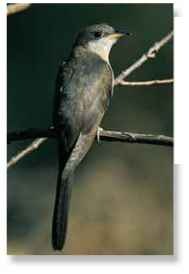
A Parental perch An adult yellow-billed cuckoo surveys the area.
The yellow-billed cuckoo lives in dense tangles of undergrowth. Once a woodland bird, it has adapted to a variety of locations, but is seldom seen in dense forests. It prefers country roadsides and willow thickets by streams and ponds, as well as orchards and brushy farmlands. The bird migrates at night and winters in the tropics of Central and South America, as far south as Uruguay It spends the rest of the year in North America, as far north as southern British Columbia in Canada. During its nighttime migrations, some cuckoos fly into TV towers.
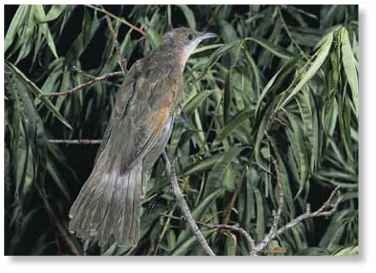
A Adolescent angst A juvenile yellow-billed cuckoo will still not have the characteristic yellow bill at the end of its fall molt.
FOOD & HUNTING
Insects — especially hairy caterpillars and beetles — are the mainstay of the yellow-billed cuckoo’s diet. The bird locates its prey by sight, scanning its surroundings from a hiding place. Camouflaged in the foliage, the cuckoo climbs with slow, stealthy movements. It grasps its prey with its curved bill, shaped for gleaning insects such as grasshoppers, tree crickets or army ants from the underside of rounded branches. The cuckoo also slips among trees and thickets in search of small frogs and lizards as well. It flies swiftly and purposefully across clearings, always heading straight from one plant to another, often foraging on fruits, including raspberries and grapes.
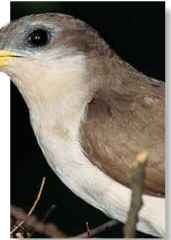
CUCKOO AT WORK
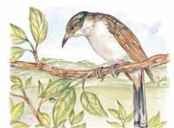
Scanning…
A yellow-billed cuckoo perches in an old apple tree, searching for prey among the branches from its hidden retreat.
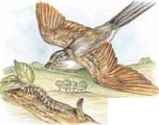
Seizing…
The cuckoo spots one of its slow-moving favorites, a hairy caterpillar, and flies down to grab the unlucky insect.
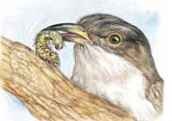
Detaching…
The bird rubs the caterpillar across a branch to remove some of its irritating hairs before swallowing it whole.
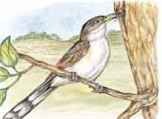
Discovering
A large black beetle is not safe from the persistent yellow-billed cuckoo, even in a crevice in the bark of the tree.
BEHAVIOR
Cuckoos were originally named for the males’ repetitive songs. The yellow-billed cuckoo is no exception; however, its song has a more guttural sound, ka-ka-ka-kow-kow-kow-kowp-kowp. This call is repeated throughout the day or night and from May to October. During the breeding season, the song seems to permeate the woods and roadside underbrush of North America. The yellow-billed cuckoo’s eyes are set so that it can see toward the rear without turning its head.This enables the secretive bird to focus on an intruder or predator approaching from behind, while still seemingly unaware and looking ahead.
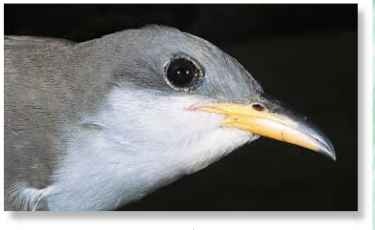
Brown surround The yellow-billed cuckoo’s large, brown eyes can focus both in front and behind.
CONSERVATION
The yellow-billed cuckoo is rare in the western U.S., and its numbers are seriously declining with the loss of its streamside habitat.The U.S. Geological Survey and Arizona Game and Fish Department are studying this cuckoo to find a solution to its problem of vanishing habitat. The use of pesticides also kills birds and thins out the numbers of available insects for food.
BREEDING
The yellow-billed cuckoo incubates and raises its own young, unlike its cousin, the European cuckoo, which deposits its eggs in the nests of other birds to be incubated and raised. The yellow-billed cuckoo builds its nest on the horizontal limb of a small evergreen tree or a thorny bush, from 2-12′ off the ground.The nest is flimsy and almost flat, made of short twigs and lined with dry leaves, grasses, moss, rags or catkins of oaks or willows.The female usually lays 3 or 4 pale, blue-green eggs at intervals of 2-3 days. Both parents share incubating duties, and the first egg hatches in 14 days.The chicks are black and covered with long, pointed feather sheaths. The parents feed the chicks insects until the young are able to climb around the nesting bush or tree at about 7-9 days old.They fledge shortly thereafter.
Sing for supper Newborn chicks open their mouths wide and beg for more insects.
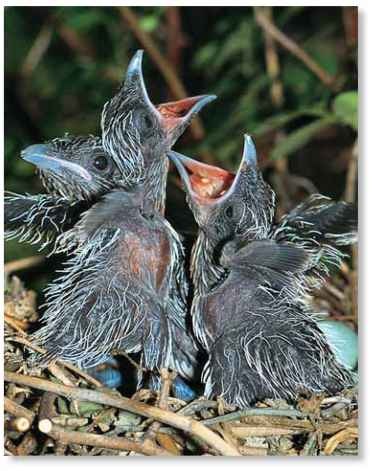
The yellow-billed cuckoo’s calls are often heard before rain storms. The bird has been given the nickname “rain crow,” and is thought to predict rain.
As many as 325 hairy caterpillars, one day’s meals, have been found in a yellow-billed cuckoo’s stomach. One cuckoo consumed 41 caterpillars in 15 minutes.
Profile
Yellow-billed Cuckoo
The yellow-billed cuckoo is able to climb trees just days after birth to forage among the branches for food — especially hairy caterpillars.
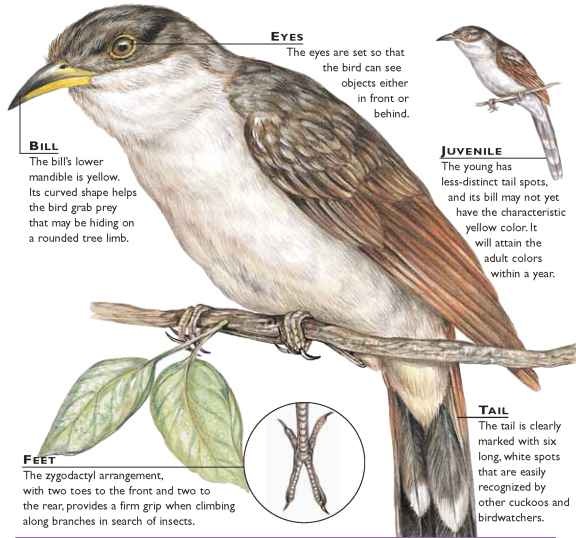
CREATURE COMPARISONS
The Didric cuckoo (Chrysococcyx caprius) measures up to 7.5″ in length and is smaller than the yellow-billed cuckoo.The male Didric is a brilliant, iridescent green, with coppery reflections, and is not as shy as the secretive and less colorful yellow-billed cuckoo. Found far from the North and South American homes of the yellow-billed cuckoo, the Didric cuckoo frequents areas of Africa, such as northern and eastern Kenya, wherever the bird can find permanent water supplies.
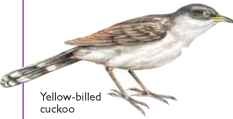
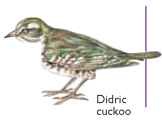
| VITAL I STATISTICS | |
| Weight | 1.5-2 oz. |
| Length | 11-13″ |
| Wingspan | 15.5-17″ |
| Sexual Maturity | About 1 year |
| Breeding Season | March-August |
| Number of Eggs | 1-5, but usually 3-4 |
| Incubation PERIOD |
14 days |
| Fledging Period | 2 weeks |
| Breeding Interval | 1 year |
| ‘Typical Diet | Mainly insects; also berries, frogs and small lizards |
| Lifespan | Unknown |
RELATED SPECIES
• The yellow-billed cuckoo’s genus, Coccyzus, includes the black-billed cuckoo, C. erythropthalmus. The roadrunner, Geococcyx californianus, and the giant coua, Coua gigas, join both Old and New World cuckoos in the family Cuculidae, which contains 138 species of, ” ‘ cuckoos and their relatives. These birds join touracos also called plaintain eaters in the order Cuculiformes.
